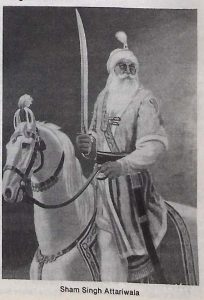

By Ranjit Kaur
Guru Nank Dev ji’s view of religion was most comprehensive. His teachings included one God, an absolute Reading beyond time and space and the infinite Universal Truth.
”God is one.
His name is True.
He is the creator.” (Japji)
“He was true in the beginning,
He was true when the agescommenced and
Has ever been true.
He is. also true now.” (Japji)
The purpose of his teachings was to attain a state of unity with Supreme Consciousness by removing all differences and inequities between people, societies and nations.
The Sikh Ideology
The Sikh ideology made a major break away from the traditional Indian thought process which regarded the World with indifference or as a place of suffering; and made “Mukti” or Salvation an ultimate goal of life. Guru Nanak’s religion was not just another sect to peruse the traditional Indian approach to religion. It was created to assist every ordinary being to strive for spiritual heights. It was created to change the unjust social system, for the uplift of down trodden and helpless people and to provide equal rights to all men and women; and to fight political domination of the unjust rulers,
To follow Guru Nanak’s path one must say Nam (Name of God) repeatedly with reverence By repeating His name i.e by reading Gurbani one realizes the Divine Truth and attains the ultimate peace. The ultimate goal of Guru Nanak’s followers (Sikhs) is to be one with God. For that goal, one must be humble and treat everyone equally. Guru Nanak says:
”The lowliest of the lowly, the lowest of the lowborn, Nanak seeks their company. The friends of the great are vain. For, where the weak are cared for, there doth thy Mercy rain” (translation by Gopal Singh).
Revolutionary concepts in Guru Nanak’s teaching
The Guru’s path was truly revolutionary. He led the downtrodden masses away from the caste system and infused courage in them to fight this evil
Hindu ‘dharma’ was a great obstacle to the idea of human rights. Guru Nanak gave a new meaning to dharma or religion. Sikh dharma meant the creation of the kingdom of God on earth where all people are equal and each one is answerable to one God. Sikh dharma prepares its followers to meet all kinds of challenges of life be they religious, political or social.
The goal of Sikh religion is to bring a change not only in an individual by facilitating an ordinary being to strive for spiritual heights but also in the social environment in order eliminate unjust social practices. Full Participation in daily life.
Guru Nanak advocated full participation in life. He denounced ascetic life and insisted an earning one’s bread by honest means. He encouraged his followers to earn their living by hard work and share their earning with others. Along with it, Guru Nanak himself took to the cultivation of land after the completion of his four uda sis”. The produce from the land went to the common kitchen which was served to all those who came to visit him and those who were needy.
Guru emphasized that the social service (Sewa) was a
Prerequisite to spiritual development and in attainment of God.
Guru Nanak believed in sharing not only his earnings but also his spiritual thoughts. He went far and wide throughout India and in neighboring countries delivering the message of God in a simple and local language so that ordinary people could understand and enjoy what he said and could apply his teachings in their everyday life. Guru Nanak’s reaching were accepted universally both by Hindus and Muslims.
To follow the teachings of Guru Nanak is not an easy path to follow. It is a rare combination of revolutionary acuteness and humility.
“Sharper than razor’s edge and thinner than hour”. (Guru Granth Sahib P.918).
It is unbearven to think, what we would have been deprived of, had Guru Nanak not come to this world. Not only would we have been living in complete darkness and under the burden of social injustice but also we would not have had our scripture Guru Granth Sahib, the ever living Guru lighting our path and leading us to our goal to be one with God.
Article extracted from this publication >> December 1, 1989